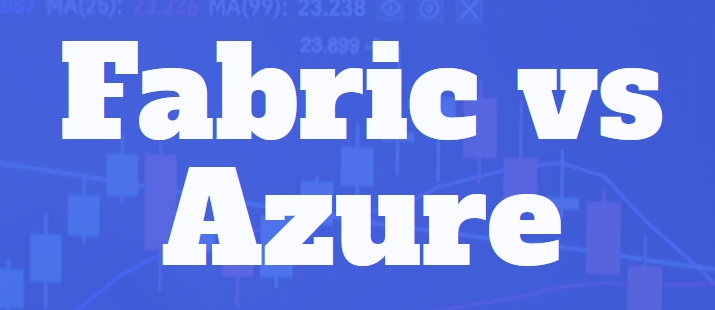During digital transformation, selecting the appropriate platform for data management and analysis is crucial. Microsoft Azure and Microsoft Fabric are both top-tier solutions, each offering distinct methods to fulfill business requirements.
Let’s look at each of the solutions, their benefits and how they serve different purposes.
Microsoft Fabric
Microsoft Fabric is a comprehensive, cloud-based Software as a Service (SaaS) platform designed to unify data management, analytics, and AI capabilities across an organization. It was officially launched by Microsoft in 2023 and has since evolved into a central hub for enterprise data operations.
Key Features of Microsoft Fabric
Unified Data Platform: Fabric integrates multiple Microsoft services—like Power BI, Azure Synapse Analytics, Azure Data Factory, and Azure Machine Learning—into a single, seamless experience.
OneLake Architecture: At the heart of Fabric is OneLake, a unified data lake built on Azure Data Lake Storage Gen2. It acts as a central repository for all organizational data, supporting open formats like Delta Lake and enabling easy data sharing without duplication.
End-to-End Workloads: Fabric supports a wide range of workloads:
- Data Engineering (Spark-based).
- Data Factory (ETL and integration).
- Data Science (ML model development).
- Real-Time Intelligence (streaming analytics).
- Data Warehousing (SQL-based analytics).
- Power BI (visualization and reporting).
- Databases (transactional data management).
Copilot Integration: AI-powered assistance is embedded throughout Fabric via Copilot, which helps users build reports, transform data, and develop ML models using natural language.
Seamless Microsoft Ecosystem Integration: Fabric works natively with Microsoft 365 (Excel, Teams), Azure, and Purview for governance, making it ideal for organizations already using Microsoft tools.
Industry-Specific Solutions: Fabric offers tailored solutions for sectors like retail, healthcare, and sustainability, with prebuilt connectors, models, and compliance features.
Benefits
- Simplifies complex data workflows.
- Reduces infrastructure overhead (serverless architecture).
- Improves collaboration across teams.
- Accelerates AI adoption.
- Supports scalable, secure, and governed data environments.
Microsoft Azure
Microsoft Azure is Microsoft’s cloud computing platform, offering a wide range of services to help individuals and organizations build, deploy, and manage applications and infrastructure through Microsoft’s global network of data centers.
Key Components of Microsoft Azure
Compute Services
- Virtual Machines (VMs): Run Windows or Linux VMs in the cloud.
- App Services: Host web apps, REST APIs, and mobile backends.
- Azure Kubernetes Service (AKS): Manage containerized applications with Kubernetes.
Storage Services
- Blob Storage: Store unstructured data like images, videos, and documents.
- File Storage: Shared file systems accessible via SMB protocol.
- Disk Storage: Persistent storage for VMs.
Networking
- Virtual Networks (VNet): Isolated networks for Azure resources.
- Load Balancer: Distribute traffic across multiple resources.
- Azure CDN: Deliver content globally with low latency.
Databases
- Azure SQL Database: Managed relational database service.
- Cosmos DB: Globally distributed NoSQL database.
- Azure Database for PostgreSQL/MySQL: Managed open-source databases.
AI and Machine Learning
- Azure Machine Learning: Build, train, and deploy ML models.
- Cognitive Services: Prebuilt APIs for vision, speech, language, and decision-making.
Analytics
- Azure Synapse Analytics: Big data and data warehousing.
- Azure Data Factory: ETL and data integration.
- Azure Databricks: Apache Spark-based analytics platform.
Security and Identity
- Azure Active Directory (AAD): Identity and access management.
- Azure Security Center: Unified security management.
- Key Vault: Securely store secrets, keys, and certificates.
DevOps and Monitoring
- Azure DevOps: CI/CD pipelines, repositories, and project tracking.
- Azure Monitor: Collect and analyze telemetry data.
Benefits of Azure
- Scalability: Easily scale resources up or down.
- Flexibility: Supports multiple programming languages and frameworks.
- Global Reach: Operates in dozens of regions worldwide.
- Security: Enterprise-grade security and compliance.
- Cost Efficiency: Pay-as-you-go pricing model.
In Summary
Microsoft Fabric is ideal for organizations looking to simplify and unify their data analytics and AI workflows without managing infrastructure.
Microsoft Azure is better suited for building and running custom applications, managing infrastructure, and deploying a wide range of cloud services.
This table should provide the key differences.
Would you like help deciding which platform is better for a specific project or use case you are working on? We are at the forefront for providing cloud computing infrastructure, including Microsoft office 365 Implementation services.

